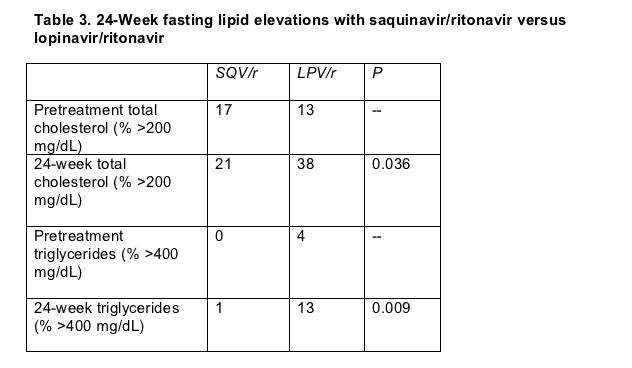 |
 |
 |
| |
SQV/r vs Kaletra, Gemini Study
|
| |
| |
Excerpted from: Boosted PIs and Other First-Line Strategies
Glasgow Meeting: Part 4
8th International Congress on Drug Therapy in HIV Infection
November 12-16, 2006, Glasgow
Mark Mascolini
Four trials presented at the Glasgow meeting offered insights into first-line fosamprenavir/ritonavir, and three of them appraised 100 mg of ritonavir once daily as the boosting dose. Other investigators sized up the merits of first-line boosted tipranavir or saquinavir, fixed-dose abacavir/lamivudine (3TC) plus atazanavir/ritonavir once daily, and an induction-maintenance scheme that fell short.
SQV/r versus LPV/r: an early look that's too early?
Saquinavir/ritonavir appeared to match lopinavir/ritonavir as a first-line boosted PI, but the preliminary and partial nature of the report stand in the way of any firm conclusions [8]. GEMINI trial researchers recruited 337 treatment-naive people at 38 sites in the US, Puerto Rico, Canada, France, and Thailand and randomized them to saquinavir/ritonavir (1000/100 mg twice daily) or standard-dose lopinavir/ritonavir with a nucleoside backbone of fixed-dose TDF/FTC (Truvada). Primary endpoints are the number and percentage of people in each arm with a load below 50 copies at week 48. The preliminary analysis presented in Glasgow by Jihad Slim (St. Michael's Medical Center, Newark) involved only the first 150 people to reach week 24.
Before treatment began the 24-week subset had a median viral load just above 100,000 copies, though 75% in the lopinavir arm versus 58% in the saquinavir arm had a starting load atop the 100,000-copy mark. Pretreatment CD4 counts averaged 134 in the saquinavir group versus 121 in the lopinavir group, and 32% starting saquinavir versus 40% starting lopinavir had fewer than 50 CD4s. A higher proportion of people in the lopinavir arm (37%) than in the saquinavir arm (28%) already had an AIDS diagnosis.
A 24-week intent-to-treat analysis found no significant difference between the two treatment arms in percent with a viral load below 400 copies (83.6% lopinavir versus 80.6% saquinavir) or below 50 copies (75.3% lopinavir versus 69.4% saquinavir). On-treatment analysis trends paralleled these 24-week intent-to-treat rates. At this point of follow-up the GEMINI team counted 5 virologic failures in the saquinavir group (6.8%) versus 2 (2.6%) in the lopinavir group. As in other studies of first-line boosted PIs, no new PI mutations emerged with any of these failures. The lopinavir group gained slightly more CD4 cells than the saquinavir group (154 versus 140), a nonsignificant difference at this point.
Whereas 58% in the lopinavir group had one or more side effects in 24 weeks, 48% in the saquinavir group did. Gastrointestinal problems including nausea, vomiting, and diarrhea affected 23% taking lopinavir and 14% taking saquinavir. Yet discontinuations proved similar in the two groups-19% taking saquinavir and 17% taking lopinavir. One person without known pretreatment liver ailments stopped lopinavir/ritonavir because of liver failure and later died. Two serious drug-related problems arose in the saquinavir group, hypokalemia and an acute psychotic episode.
Fasting cholesterol and triglyceride elevations were similar in the two study arms before treatment began, but both rose more often in the lopinavir group (Table 3).

All these results must be considered preliminary because they represent fewer than half of the study population, and because the lopinavir group appeared to have more advanced HIV infection when treatment began. An earlier comparison of the same doses of saquinavir/ritonavir and lopinavir/ritonavir in 324 patients--about one third of them treatment naive--found a faster time to treatment failure in the saquinavir arm at week 48.[9] The GEMINI researchers could not present a time-to-treatment-failure analysis because of the limited number tracked to week 24. In the earlier trial [9] significantly more people discontinued treatment by week 48 in the saquinavir arm (29%) than in the lopinavir arm (13%) (P = 0.001).
|
| |
|
 |
 |
|
|